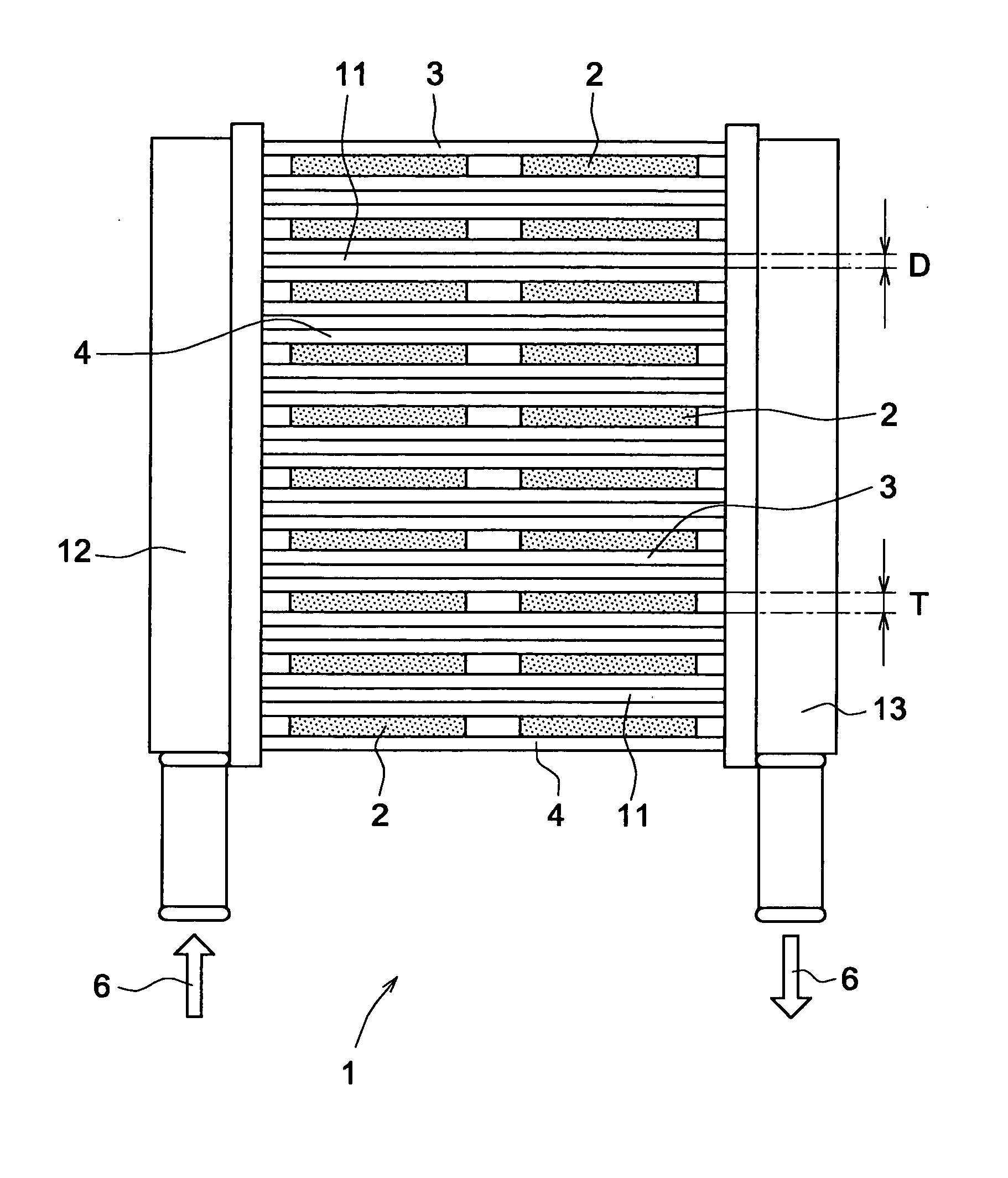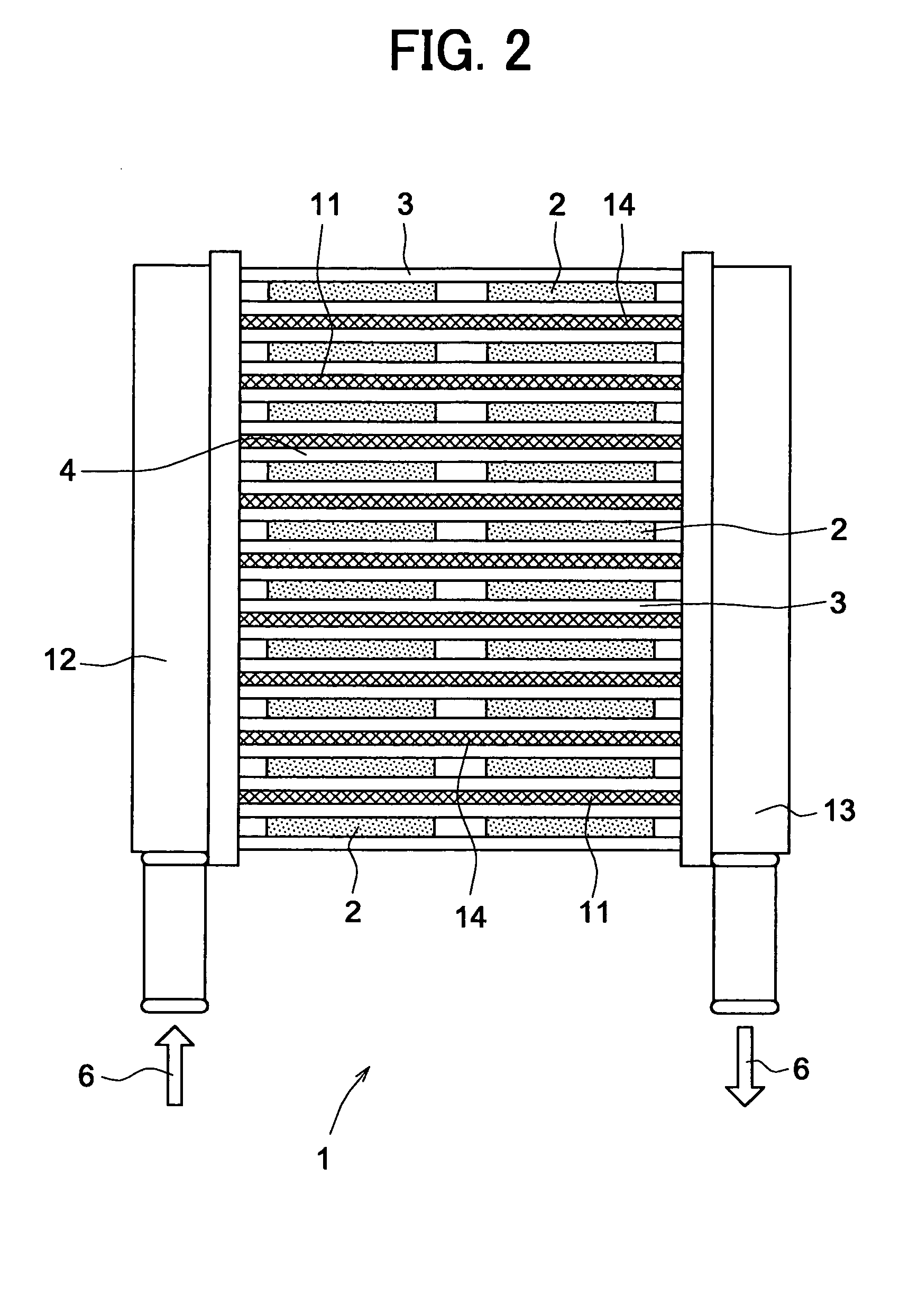Cooler for cooling electric part
a technology for electric parts and coolers, which is applied in the direction of cooling/ventilation/heating modifications, semiconductor/solid-state device details, cooling/ventilation/heating modifications, etc., can solve the problems of reducing affecting the cooling performance of the cooler, etc., to achieve high cooling performance
- Summary
- Abstract
- Description
- Claims
- Application Information
AI Technical Summary
Benefits of technology
Problems solved by technology
Method used
Image
Examples
first embodiment
[0039] (First Embodiment)
[0040] A cooler 1 according to a first embodiment of the present invention is shown in FIG. 1. The cooler 1 cools multiple electric parts 2 on both sides thereof. The cooler 1 includes a cooling unit 4 having a pair of cooling tubes 3 for passing coolant 6 therethrough. The cooling tube 3 has a flat shape. A pair of the cooling tube 3 sandwiches two electric parts 2 disposed in parallel. Multiple cooling units 4 are stacked in a stacking direction, which is parallel to a thickness direction of the cooling tube 3. A clearance 11 is disposed between the neighboring cooling units 4. The clearance 11 is disposed between one cooling tube 3 and the other cooling tube 3. Specifically, the clearance 11 is disposed between one side of the one cooling tube 3, which is opposite to the electric part 2, and another one side of the other cooling tube 3, which is opposite to the other electric part 2. The thickness D, i.e., the width of the clearance 11 is smaller than the...
second embodiment
[0050] (Second Embodiment)
[0051] A cooler 1 according to a second embodiment of the present invention is shown in FIG. 2. The cooler 1 includes a heat insulation member 14 inserted into the clearance 11. The heat insulation member 14 is made of resin having low heat conductivity and elasticity such as silicone plate, fluorine resin plate, resin filler, or rubber plate.
[0052] In this case, the heat generated in one electric part 2 is prevented from transferring to another electric part 2. Therefore, the cooler 1 has high cooling performance. Since the heat insulation member 14 has the elasticity, the different thickness T of the electric part 2 can be absorbed into each cooling unit 4, i.e., the heat insulation member 14. Thus, the electric part 2 is precisely sandwiched and fixed by the cooling tube 3. Accordingly, the cooling performance of the cooler 1 is improved.
third embodiment
[0053] (Third Embodiment)
[0054] A cooler 1 according to a third embodiment of the present invention is shown in FIGS. 3 and 4. The cooler 1 includes a stopper 5. The stopper 5 includes multiple convexities 51 and concavities 52. The convexity 51 has almost the same width as the thickness D of the clearance 11. The concavity 52 has almost the same width as the thickness of the cooling unit 4. The stopper 5 is inserted in the cooling unit 4 such that the convexity 51 is inserted into the clearance 11 and the cooling unit 4 is inserted into the concavity 52.
[0055] As shown in FIG. 3, the stopper 5 is disposed at a center position of the cooling tube 3 in a longitudinal direction. Specifically, the stopper 5 is disposed between two electric parts 2 disposed in parallel, and is perpendicular to the cooling tube 3. The concavity 52 of the stopper 5 is formed to have a tapered shape, which includes inner walls slightly slanted. After all of the electric parts 2 are inserted into the coole...
PUM
 Login to View More
Login to View More Abstract
Description
Claims
Application Information
 Login to View More
Login to View More - R&D
- Intellectual Property
- Life Sciences
- Materials
- Tech Scout
- Unparalleled Data Quality
- Higher Quality Content
- 60% Fewer Hallucinations
Browse by: Latest US Patents, China's latest patents, Technical Efficacy Thesaurus, Application Domain, Technology Topic, Popular Technical Reports.
© 2025 PatSnap. All rights reserved.Legal|Privacy policy|Modern Slavery Act Transparency Statement|Sitemap|About US| Contact US: help@patsnap.com



